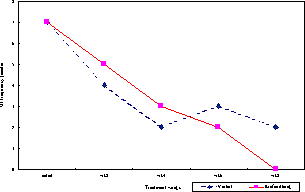|
The Comparative Effectiveness Between Verbal and Biofeedback-Assisted
Instruction of a Pelvic Floor Muscle Training Program in Managing Female
Incontinence
Chuan-Hisu Tsai
Tzu-Chi College of Technology Department of Nursing
Aim of Study: The purpose of this study was to examine the effectiveness
of a pelvic floor muscle training(PFMT) program in Taiwanese middle age and
older women with urinary incontinence (UI), with a specific focus on
comparing the effects of verbal and biofeedback-assisted instruction.
Method: A prospective randomized trial was conducted to examine the
effects of two different instruction methods on UI frequency and subjects’
adherence were examined. The verbal instruction group received 8 verbal
instruction sessions, while the biofeedback-assisted exercise group was
taught pelvic floor muscle exercise through 8 weekly perineal
electromyography-assisted instruction sessions. Nonparametric tests was used
to analyze the data. The main outcome variables included %reduction of UI
and self-report exercise adherence.
 Results:
98 subjects were included based on the inclusion and exclusion criteria, and
69 subjects completed the treatment protocol. At baseline, there were no
significant differences between the two groups in the severity or type of UI
or in demographic and health-related characteristics. After the 8-week
intervention, both groups demonstrated significant decreases in UI frequency
(p<0.001). The biofeedback-assisted instruction group performed
significantly better percent reduction (85% vs 58%) than the verbal
instruction group (p<0.01). Secondary, 47% of the subjects assigned to the
verbal intervention dropped out of the study in contrast to a dropout rate
of only 12% among those Results:
98 subjects were included based on the inclusion and exclusion criteria, and
69 subjects completed the treatment protocol. At baseline, there were no
significant differences between the two groups in the severity or type of UI
or in demographic and health-related characteristics. After the 8-week
intervention, both groups demonstrated significant decreases in UI frequency
(p<0.001). The biofeedback-assisted instruction group performed
significantly better percent reduction (85% vs 58%) than the verbal
instruction group (p<0.01). Secondary, 47% of the subjects assigned to the
verbal intervention dropped out of the study in contrast to a dropout rate
of only 12% among those
randomized to the biofeedback group. Lastly, self-report PFMR adherence of
the biofeedback instruction group was significantly higher than the verbal
instruction group (p< .001).
Conclusion: Both verbal and biofeedback-assisted instructions were
comparative effective in managing female UI. However, the the
biofeedback-assisted instruction group demonstrated a significantly higher
exercise adherence and less drop-out from the program.
|